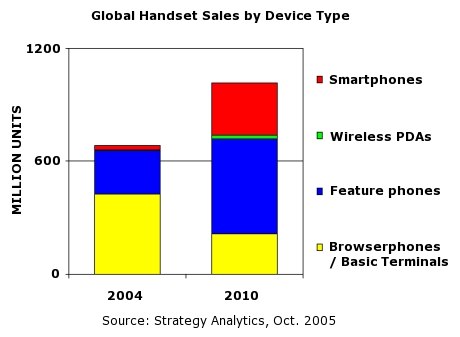OSDL aims multivendor initiative at Linux mobile phones
Oct 17, 2005 — by LinuxDevices Staff — from the LinuxDevices Archive — viewsThe OSDL today launched the Mobile Linux Initiative (MLI), an effort to accelerate adoption of Linux in mobile phones — one of the fastest growing consumer device segments. Linux is already among the top three OSes in “converged” mobile phones, according to industry analysts, and has shipped in Motorola handsets since 2003.
The OSDL (Open Source Development Labs), which employs Linux creator Linus Torvalds and strives to be the “center of gravity” for Linux, has long been rumored to have an embedded Linux project in the works. The organization last summer hired embedded expert Bill Weinberg, and more recently, took over stewardship of the Embedded Linux Platform Specification following the demise of the ELC (Embedded Linux Consortium). OSDL CEO Stuart Cohen said in April that the organization would get involved with embedded given enough member interest.
And indeed, Linux has turned out to be hugely interesting to mobile phone vendors, many of whom already belong to the OSDL because of its Carrier Grade Linux initiative.
The OSDL cites research from market researcher Ovum stating that worldwide mobile phone sales grew 31 percent in 2004, and that more than 2.8 billion phones are expected to be in use by 2009. “Linux has enormous potential in the mobile space as it is well placed to meet growing demand for handsets that deliver both flexibility and advanced features,” commented Ovum research director Gary Barnett. “OSDL and its members are in a position to help facilitate a shift for handset manufacturers moving to Linux.”
The MLI's focus will be to “maximize the market opportunity for Linux-based devices,” the OSDL said, in a statement issued today. The group has not listed specific tasks, other than that MLI working group members “will work on operating system technical challenges, foster development of applications for Linux-based mobile devices, deliver requirements definition documents and use cases, and host complementary open source projects that support the initiative.”
“As the mobile market continues to explode, handset manufacturers are increasingly turning to Linux as a strategic platform to deliver more capable mobile devices, increase flexibility, speed time-to-market, and lower costs,” the OSDL added.
Initial MLI working group members include OSDL members MontaVista Software, Motorola, PalmSource (which announced today that it has joined the OSDL), Trolltech, and Wind River.
MontaVista launched its own Linux Mobile phone initiative last April. MontaVista's “Mobilinux” platform is based on a 2.6 kernel with real-time and power-management enhancements, and targets “feature-phones” as well as the higher-end smartphone devices.
Interestingly, the name “Mobile Linux Forum” seems to resonate with MontaVista's “Mobilinux” brand, in what could be a political acknowledgement from founding members of MontaVista's early leadership in Linux phones. The company's Linux OS has shipped in about ten phones from three vendors so far.
Trolltech has been shipping a mobile phone software stack targeting Linux Mobile phones for several years. Trolltech's Qtopia Phone Edition offers PDA-like features on feature-phone level hardware, and supports both keypad- and touchscreen-oriented devices.
PalmSource announced last December that it was planning to convert PalmOS into a middleware and application stack for Linux mobile phones. The company said “PalmOS for Linux” would target smartphone manufacturers in China, initially, and that it had acquired China MobileSoft, a company already successful in the Chinese mobile Linux market. Recent rumors suggest that Linux mobile phones incorporating PalmSource software, combined with a Linux OS supplied by Wind River, may soon ship.
PalmSource last March joined CELF (Consumer Electronics Linux Forum, another organization devoted to improving Linux for mobile and consumer applications. CELF maintains a collection of patches aimed at improving power management, boot time, and similar characteristics on specific processors and processor architectures.
Wind River earlier this month announced its own consumer electronics Linux distribution targeting mobile phones, set-top boxes, PVRs (personal video recorders), and other small-footprint consumer devices, and said it expected its “Platform for Consumer Electronics, Linux Edition” to be used in several mobile phone designs shipping before 2006.
Motorola, the number two global manufacture of mobile phones, announced in February 2003 that it planned to manufacture mobile phones based on a Linux/Java software platform. The company's growing portfolio of Linux Mobile phones has since combined MontaVista's Linux OS, Trolltech's Qt/Embedded GUI platform, and the company's own proprietary application stack.
Market perspective
Symbian currently dominates the market for “converged mobile device operating systems,” and will gain marketshare through 2009, according to a report released in July by IDC. Windows and Linux will also grow, each reaching about 17 percent marketshare by 2009, IDC said.
IDC said Symbian enjoyed a 55.9 percent share of the converged mobile device operating system market in 2004, projected to reach 60 percent in 2009. Microsoft Windows Mobile claimed a 12.7 percent share in 2004, projected to reach 17.3 percent in 2009. Linux had an 11.3 percent share in 2004, projected to reach “nearly 17 percent” by 2009, according to IDC.
Another analyst firm, Gartner, reported in May that Linux enjoyed a 13.7 percent share of the smartphone operating system market during the first quarter of 2005, compared to 4.5 percent for Windows Mobile. That report did not include Pocket PC phones from Microsoft, however.

Strategy Analytics says its research indicates that mid-range and high-end handsets are the fastest growing mobile phone market segments, as shown in above graph. The analyst firm projected earlier this year that feature-phones would account for around 50 percent of some 725 million mobile phone shipments in 2005, with smartphones scoring roughly six percent.
This article was originally published on LinuxDevices.com and has been donated to the open source community by QuinStreet Inc. Please visit LinuxToday.com for up-to-date news and articles about Linux and open source.